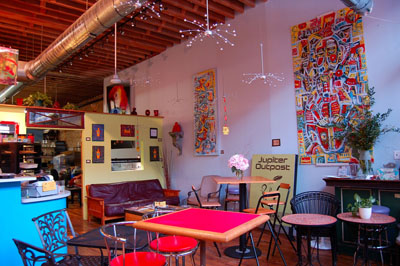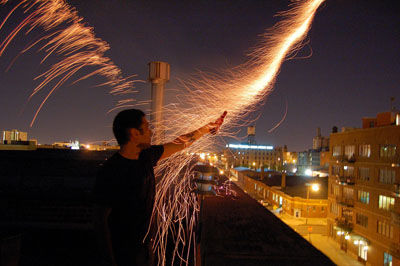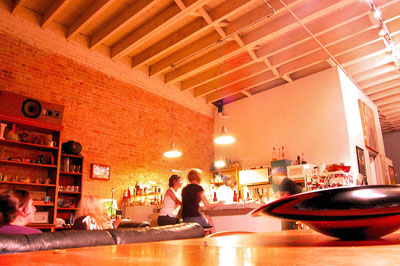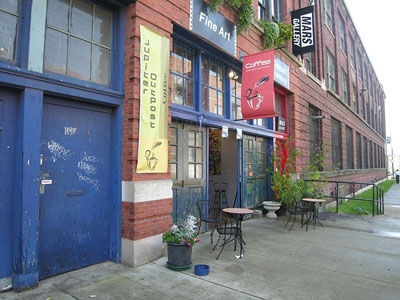Jupiter Outpost café owner, John Dymond gestured toward the way back corner of his coffee shop in the market district of Fulton Street. "They're called Vortex fields." His tone was laced with sarcasm, but his flattened palm smeared out impressionistic circles in the air. "Do you feel anything different?"
A relatively new addition to the area, Jupiter is an eclectic neighborhoody joint; almost every piece of the second-hand furniture inside is compliments of long-time area residents — a plush burgundy futon set aside shiny, crimson-topped stools and light brown wicker chairs, as well as a rotating handful of off-beat periodicals and paperbacks. Snickery décor like the small grab bag of offbeat sex toys, a red-eared slider turtle named Bebe and a sign in the bathroom that some picaresque has altered to read, "All employees must [hail Satan, and] wash hands" recalls a handful of '90s sitcoms while the occasional flower bouquets — gifts from doting neighbors — speak to the loyal and appreciative clientele. The café will soon undergo extensive renovations, including a proper kitchen, but for the time being, owners are determining the layout. As Dymond revealed, the Fulton Street Vortex, which runs through the back corner of the shop, plays into the planning.

photo by Libby Ramer
Along with a handful of residents, Dymond believes that the market district hosts a "good feeling" energy force, a kinetic spire that surges from the concrete, capable of inducing creativity and comfort. It's a bit of an anomaly. Whereas most vortices hail from Sedona, that hazy oasis of quartz crystals and canyon mystics, the Fulton Street Vortex is woven into the pragmatic, trade-and-labor fabric of Chicago — the only occurrence in an urban setting. Furthermore, it's entirely devoid of hype; for now it even lacks its own informational brochure. In fact, the folks at Jupiter found out about it from their namesake neighbor, Mars Gallery. Radiating in a northeasterly direction, the epicenter of the oblong-shaped vortex is located chiefly inside the gallery. According to the Mars website, it fluctuates at "the western wall, about 70 feet south of the Fulton Street side of the building." Jupiter Outpost catches a portion of the spire, as do some of the spaces nearby. But for the most part, the energy is contained within a small radius, emanating innocuously to little fanfare.
Despite an imposing, pulps-tinged moniker, it turns out The Fulton Street Vortex has pretty limited powers. The Vortex has neither an arch nemesis nor a moral agenda. According to local parapsychology researcher and historian Ursula Bielski, who claims to know a bit about the district's energy field, neither precognition nor teleportation can be achieved via the Vortex. Bielski puts it bluntly, "An energy vortex is a patch of spiraling energy believed to come from the earth. It is entirely different from a portal, which is an alleged spiritual doorway between the physical and spiritual worlds. A vortex is a physical phenomenon of some sort."
"It does not have a moral connotation per se," she continues, "but some believe that vortexes, because of their funnel-like energy, may "trap" the energies in their locale... that if you travel to a vortex site and have bad energy in yourself you'll attract evil spirits or energy to yourself," and vice-versa. She also says that gathering phenomenological evidence or interviewing those in the vicinity is, arguably, the only way to get proof of the vortex's existence.
"I think it's all a bunch of hooey," says one local, Joshua. "If there is a vortex, I can honestly say I haven't benefited from it," he laughs. Joshua moved to the area to upstart an eco-friendly sculptural furniture company in a gallery space (and former fortune cookie factory) about seven years ago. He is quick to credit Jupiter Outpost, though, commenting, "I've met more neighbors during the time the coffee shop has been going than the whole time I lived here before."
"Most of the time, people come [to the district] and say it's desolate," says Barbie Gadzuk, the pretty, wry-humored blond who co-owns Mars Gallery. "No it's not." An early promoter of art in the city's manufacturing corridor, the Mars space has hosted — even before the gallery's inception in 1988 — a lot of legend and lore. Gadzuk tells me that people started coming by to drop stories about its events and functions from the past here. "People would approach us and say 'We've been here before,'" she says. "We weren't asking the people, they just offered it. They weren't saying six months ago, they meant a while back." Fashion shows, bands, people claiming to have seen the Ramones, photoshoots, etc. The Vortex, which she heard about from several such visitors, she initially thought of more like folklore, though after awhile, it did add up. People would walk into the space and frequently remark how it "feels good."

photo by Libby Ramer
After about 15 minutes, Gadzuk ducks into a back room, emerging minutes later with boxes and trays brimming with pictures and clippings. Fliers brush by; one reads, "Party: Pagan Rituals. Witness amazing shit. Buy art. Drink at the vertically mobile bar. Dress Pagan."
She shows me newspaper clips about an event held at Jerry Kleiner's now defunct pre-Victor Hotel club, Shelter, and I let it slip that I don't know much about the place. "You don't know about Shelter?" Gadzuk remarks, facial expression speculating my date of birth. "There was no sign and a hidden door," she explains politely. "Inside it was big and opulent... when you had company from out of town you'd take them there." Around the summer of 1990, Mars Gallery sponsored a graffiti party; Peter Mars imported taggers from Northwest Indiana, dubbed the Crazy in Style Artists; the crew went by such colorful monikers as Rooster, Oms-One and Trazy Traz. Along with Barbie and Peter, they painted a 16' by 40' black triptych, entitled, 'Past, Present & Future'. An article referring to Peter Mars as simply, "art guy," doesn't mention the fact that Shelter painted over it all the next day.
I ask why not many people seem to know about the Vortex. "For one thing," Gadzuk says, "most people living in the area are older, established artists that have slowly uncovered the past from stories, word of mouth." She veers slightly off topic, "One time, one guy about 35 years old who does business down the street told me about the drag racing up and down the strip," she laughs, "that type of thing. Funny thing is, prior to [Mars] we were in New Orleans... in the French Quarter. When we moved in, the phones were wacky; the jacks were a little weird. The phone guy came out... one of the neighbors said 'the guys that used to live here worked for Bell South and they rewired the place.' I was like, 'Oh yeah...' They wired it so [partygoers] could bring their phone [console] to plug in."
"There used to be a big mushroom mural," she laughs, "We keep finding ourselves in the middle of a party. The energy changes as the group changes, but it is always positive."
If there's one thing that's palpable, it's the separation of "parties" in the district. The gap between rooted, area artists and the younger generation of transients from the suburbs or neighboring states, schooling at the Art Institute and Columbia, taking up nearby or at the art space, Mr. City.
"I think I saw a real crappy 'psychedelic' art show there once," said one young, local resident who hadn't heard of the Vortex at the gallery.
This disparity means that area stories have been covered, buried or scrapped, idly passed along or preserved temporarily in boxes. The amount of information is intriguing: While other creative epicenters have been documented extensively, Fulton Market's history hasn't quite followed suit. Will the stories disappear? Or are they fleeting luxuries of anonymity and privacy temporarily preserved in the meat packing district? It's well known that the Fulton of real estate showings is deceptively tranquil; day trips devoid of the night rumblings of the warehouses and the sound of muffled exclamations from market workers often fool casual visitors.
"I think [news of the Vortex] will probably be a shock to most people living in the area who've moved in within the last five years, but the people that have lived there for a while longer have probably been told by the long time residents," says Kipp, who was hired as a commercial film producer shortly after moving to the area in 1995 and credits the streak of fortune to the loft space he rented on Fulton — just above Mars. "I visited the loft one time before I moved in and told my friends [who were currently living there] that if they ever decided to move they needed to call me right away," he told me. "They did just that and I let my landlord know I had an opportunity to move into a huge artist's loft. I took him to Fulton and he ripped the lease up that day and said, 'you lucky bastard.' Thank God he was cool about it or things might have been different."
Kipp remembers being told about the Vortex by Mars and Gadzuk, thinking that it made sense at the time. "I had incredibly powerful moments of clarity while I lived there," he says, and "felt so comfortable like it was always supposed to be my home during that time. Ironically, I found out that my Grandfather had sold produce from his farms on Fulton Market long before I was ever born and even after that. I ended up riding in the truck with him to deliver his goods and didn't even know I'd be living there 20 or so years later." He recalls a few incidents, one of which includes "an incredible, almost electric energy rushing through my body and my stomach became extremely warm" and the extraordinary healing of his family's pet dog, "I could never forget how the dog reacted to what I thought was a defining moment for the Vortex." Kipp adds, "I constantly wonder if Ira Sapir, who moved in after I left, has experienced anything similar. I feel like that building can bring out the best in anyone." As this last comment — and this increasingly tied-in social circle — reveals, the Vortex has something in common with a lot of locals. Whether it's a piece of folklore or some scientific variant, the invisible phenomenon serves as a quick reference link between the established residents and the history of the Market.

photo by Libby Ramer
Sapir, an artist whose work has appeared at the Metropolitan Museum of Art and the Hokkaido Museum of Modern Art in Japan, moved to the area in 1985. "I'd bring a lady here after the bar and they'd say, 'where are you taking me?'" he laughs. The area warehouse parties were in full swing, precursors to the raves, and it was mainly new artists who joined him in the late '80s, Warholian wannabes drawn to the open spaces or in it for the modest rent.
It was shortly after that, around '86, that Sapir opened up a lounge called Out Takes. The concept for the place came when friend, local photographer Peter Rosenbaum, returned from an assignment in Nicaragua for Time on the heels of the Contra rebel insurgencies. As it turned out, Rosenbaum's images were too gruesome — no one would accept them — but Sapir said he'd show them and he did. From that point on, the intent behind Out Takes was to feature art, photography and other media from artists that hadn't been accepted, but that was quality work, nonetheless. What artists did, but not what they were known for. The bar itself looked like a fish tank — glass on top and front. "The water was filled to the surface," Sapir explained, "like a lens." Artists stopped in to drop off glass from their travels, trying to one-up the other. While the walls ensured that artistic energy went acknowledged, the blurry 12-foot high, 20-inch deep aquarium captured Sapir's circle of friends.
According to Sapir, there were once 1,000 people there on a Friday night, from word of mouth alone, when A&M Records took up shop and sloshed around jugs of moonshine. "I came home that night and passed out, didn't quite make it up [the stairs to the apartment], but these guys over there put four cones around me so I could sleep," Sapir says, gesturing down the street. "These guys next door at the egg store." He continues to look around and sighs loudly, melodramatically, "When you can't find a place to park anymore... "

photo courtesy of YoChicago
As we're sitting in the porch chairs outside of Jupiter Outpost, a pretty girl meanders up, legs unshaven and wrinkled clothes naïvely ill-fitting, she begins fiddling with the knob of the café when the heavy wood doors won't give.
"Is that the Mayan astrological symbol?" perks up area resident Murray, craning around in his nearby chair to get a look at the sign on her shirt.
"Oh, is that what it is," the girl answers breathily, looking down and pulling at her top. "I wasn't sure... I just got it today..." Someone lets the girl know the coffee shop is closed — with its 5pm shut-down, the notice will be repeated several times before dark. As she leaves, I ask Murray, who owns an alternative media company in the area and moved to Fulton Market from the North Side fairly recently, what prompted his move west. "It had a better feel," he says. "When I looked around Lakeview there were all these 'me's'... 10 me's everywhere I looked." When he and his wife walked into a local business in Fulton Market, the store owner asked, "Who are you?" Murray says that's when he knew it was the place for him.





